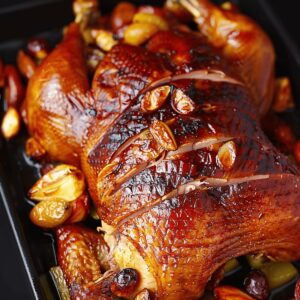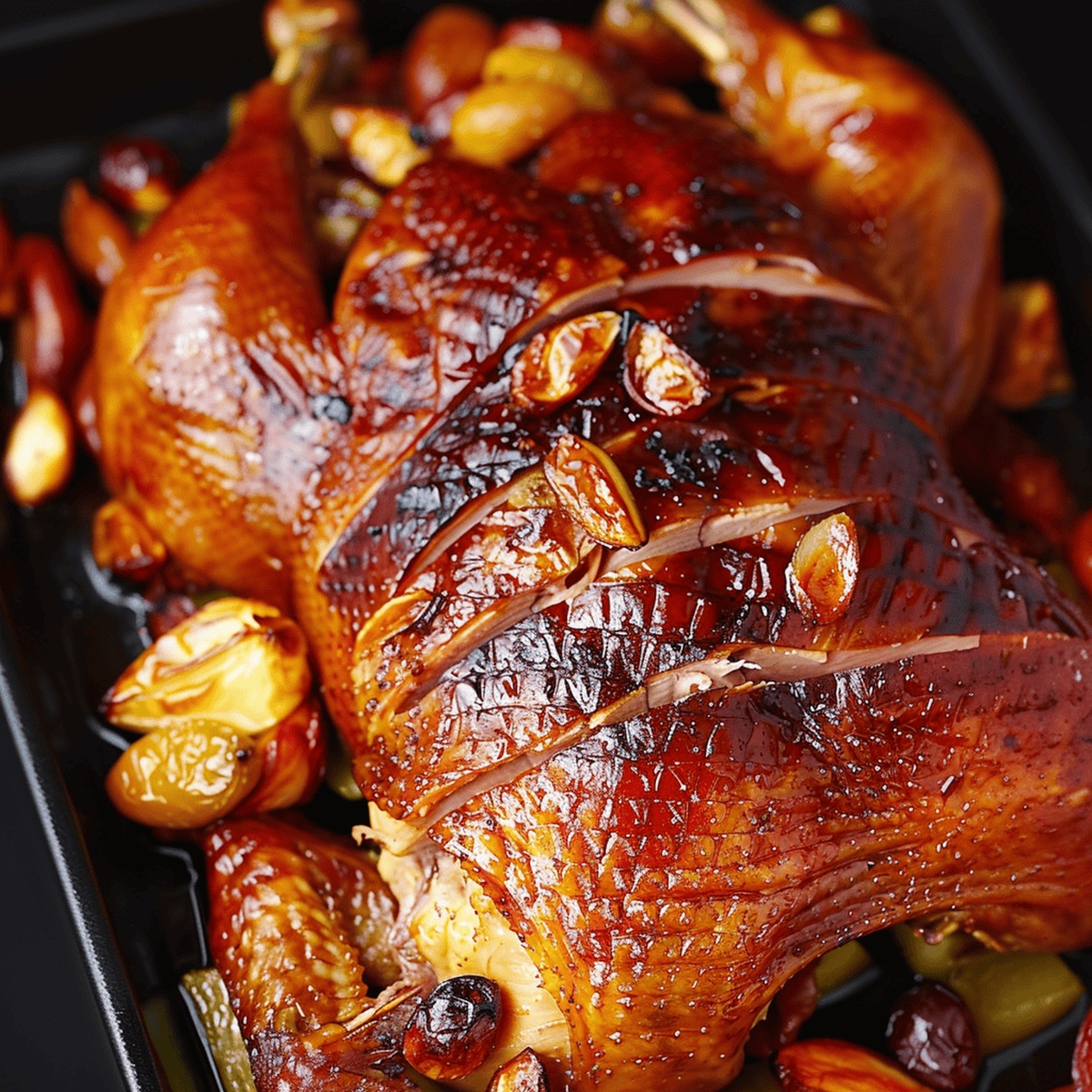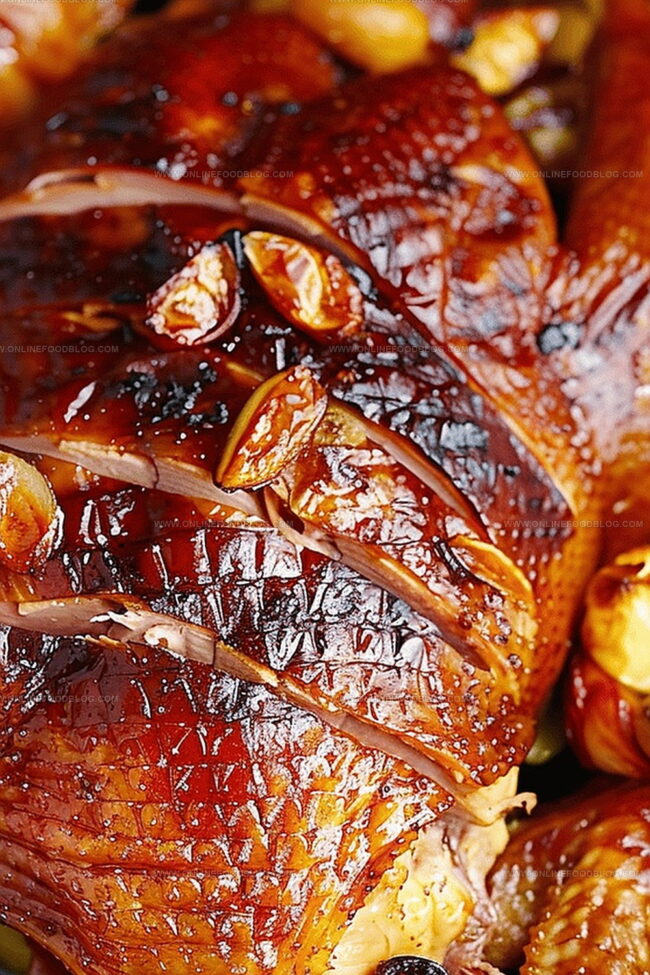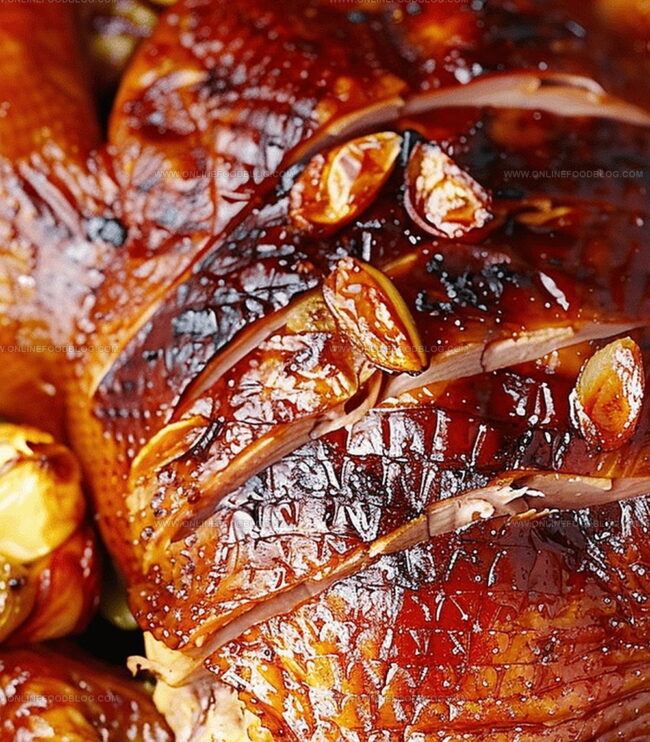Crispy Classic Roast Duck with Honey-Balsamic Glaze Recipe
Golden, crispy skin and succulent meat define this classic roast duck with honey-balsamic glaze that will make your taste buds dance.
Roasting duck might seem intimidating, but this recipe breaks down every step with precision and ease.
The combination of sweet honey and tangy balsamic creates a glossy, irresistible coating that caramelizes beautifully during cooking.
Rich, deep flavors penetrate every tender morsel of meat, promising a restaurant-quality meal straight from your kitchen.
Each slice reveals a perfect balance between crisp exterior and juicy interior that melts in your mouth.
The secret lies in careful preparation and a simple yet sophisticated glaze that turns an ordinary dinner into an extraordinary culinary experience.
Get ready to impress everyone at the table with this show-stopping duck dish that promises pure deliciousness.
Quick Recipe Overview
Ingredients for Classic Roast Duck with Honey-Balsamic Glaze
For Main Protein:For Seasoning and Flavor Enhancers:For Glaze and Finishing:Miscellaneous Preparation Items:Tools to Roast the Best Honey-Balsamic Glazed Duck
Step-by-Step for Cooking Classic Honey-Balsamic Duck
Remove frozen duck from packaging and place in refrigerator to defrost gradually. Allow several days for complete thawing. Set duck on counter 30 minutes before cooking to reach room temperature.
Position rack in large roasting pan. Heat oven to moderate temperature around 350°F. Clean duck thoroughly, removing internal organs. Pat entire surface dry with clean towel.
Create shallow diagonal cuts across duck skin to help release fat during cooking. Sprinkle generous amount of salt inside and outside of duck. Insert whole garlic cloves and citrus pieces into cavity. Secure legs using kitchen twine.
Place duck breast side facing upward. Cook for initial 40 minutes. Carefully flip duck, continue roasting additional 20-40 minutes. Monitor internal temperature for proper doneness.
Combine tangy vinegar, sweet honey, and bright citrus juice. Brush mixture over duck surface periodically during final roasting stage. This creates beautiful caramelized exterior.
Remove duck when internal temperature reaches 155°F. Allow meat to rest, which helps juices redistribute. Carve carefully and serve immediately while warm and succulent.
Glazing Tips for Classic Roast Duck
Serving Ideas for Honey-Balsamic Glazed Roast Duck
Make-Ahead Tips for Classic Duck with Honey-Balsamic Glaze
Print
Succulent Roast Duck With Honey-Balsamic Glaze
- Total Time: 22 minutes
- Yield: 5 1x
Description
Succulent roast duck with honey-balsamic glaze showcases French culinary excellence, delivering rich flavors through careful preparation. Crisp skin and tender meat promise a memorable dining experience you will savor completely.
Ingredients
- 6 lb (2.7 kg) whole Pekin duck
- 1 small or medium lemon, chopped
- 5 garlic cloves, chopped
- ½ cup (120 ml) balsamic vinegar
- ¼ cup (60 ml) honey
- Juice of 1 lemon
- Salt (to taste)
Instructions
- Preparation: Thaw duck in refrigerator for 48 hours, then rest at room temperature for 30 minutes. Preheat oven to 350°F (175°C) with rack positioned in large roasting pan.
- Cleaning and Scoring: Remove giblets, rinse duck inside and out, pat completely dry. Create precise diamond-shaped scoring pattern on skin to enhance fat rendering and promote crispy texture. Puncture fatty areas to encourage fat release.
- Seasoning and Stuffing: Generously salt duck’s cavity and external skin. Stuff interior with whole garlic cloves and fresh lemon wedges. Truss legs securely using kitchen twine to ensure uniform cooking.
- Initial Roasting: Place duck breast-side up in roasting pan. Cook for 40 minutes, then carefully flip breast-side down and continue roasting for additional 20-40 minutes, monitoring internal temperature.
- Honey-Balsamic Glaze: Whisk balsamic vinegar, lemon juice, and honey until well combined. When internal temperature reaches 140°F (60°C), flip duck breast-side up and begin glazing.
- Finishing and Glazing: Brush duck with prepared glaze every 10 minutes during final 40 minutes of roasting. For extra crispy skin, broil for 5-10 minutes, watching carefully to prevent burning.
- Resting and Serving: Remove duck from oven when internal temperature reaches 155°F (68°C). Allow to rest until temperature naturally increases to 165°F (74°C). Discard lemon and garlic, carve carefully, and serve immediately.
Notes
- Prevent Fat Splatter: Cover the bottom of the roasting pan with aluminum foil to catch excess fat and make cleanup easier.
- Maximize Crispiness: Ensure the duck skin is completely dry before scoring and seasoning to achieve a perfectly crisp exterior.
- Temperature Precision: Use a reliable meat thermometer to accurately monitor the internal temperature for perfectly cooked, juicy meat.
- Resting is Crucial: Let the duck rest after cooking to allow juices to redistribute, ensuring each slice remains tender and flavorful.
- Prep Time: 20 minutes
- Cook Time: 2 hours
- Category: Dinner
- Method: Roasting
- Cuisine: French
Nutrition
- Serving Size: 5
- Calories: 580
- Sugar: 14 g
- Sodium: 250 mg
- Fat: 42 g
- Saturated Fat: 11 g
- Unsaturated Fat: 28 g
- Trans Fat: 0 g
- Carbohydrates: 33 g
- Fiber: 0 g
- Protein: 20 g
- Cholesterol: 100 mg




Mia Reynolds
Food Writer & Home Cooking Specialist
Expertise
Easy Home Baking, Recipe Writing and Storytelling, Local and Seasonal Ingredients, Baking for Beginners
Education
New England Culinary Institute (NECI), Montpelier, Vermont
Community College of Vermont, Winooski, Vermont
Mia Reynolds fell in love with baking as a teenager experimenting in her family kitchen. Her passion took her to New England Culinary Institute, where she learned practical pastry techniques, and later to Community College of Vermont to deepen her understanding of food management.
Mia combines clear, simple baking instructions with heartwarming stories, making home baking approachable for everyone.